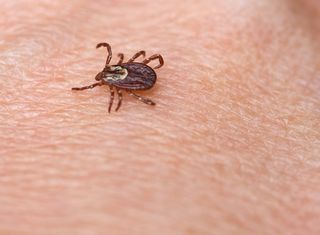Mysterious Skin Condition 'Morgellons' Not Contagious, Study Says

The cause of a mysterious condition that haunts its sufferers with sensations of crawling bugs and fibrous material embedded in the skin may be one step closer to being found, a new study suggests.
The condition, commonly referred to as Morgellons, does not appear to be contagious, according to a new report from the Centers for Disease Control and Prevention.
"This alleviates concerns about the condition being contagious between family members and others," said Mark Eberhard, Director of CDC's Division of Parasitic Diseases and Malaria.
People with Morgellons report having symptoms manifesting on their skin. These include non-healing skin lesions, the emergence of fibers or solid material from the skin, and disturbing sensations, such as crawling, stinging or biting. Some patients report fatigue, memory loss and a substantial decline in quality of life, according to the study.
The study was undertaken after the CDC received a number of calls over the last 10 years with reports of the condition, Eberhard said.
"We had no idea what it was or might be," Eberhard told MyHealthNewsDaily. "We felt very compelled to do something. It was quite clear that people were suffering."
The report still does not identify a cause of the condition, and Morgellons is not recognized as a distinct medical disorder. However, by ruling out an infectious cause, researchers have begun to narrow down what health care providers need to look for when patients report signs of the condition, Eberhard said. And it's likely that different factors contribute to individual cases.
Sign up for the Live Science daily newsletter now
Get the world’s most fascinating discoveries delivered straight to your inbox.
"I don’t think there's going to be a single diagnosis that will fit across the spectrum of it," Eberhard said.
Unexplained disease
Eberhard and colleagues identified 109 patients with this condition by searching the electronic medical record database of Kaiser Permanente of Northern California. The researchers estimate the condition is rare, found in about four out of every 100,000 people.
Patients were put through a battery of tests to identify possible causes, including a medical exam, skin biopsies and psychiatric and blood testing. Fibers and solid material was extracted from the patients' wounds, and their composition was examined.
"There's been a great deal of fixation, on everybody's part, with those fibers," Eberhard said. Previous reports included patients bringing fibers they said had emerged from their skin to their doctors, but "there was no way to validate, scientifically, where the fibers came from," Eberhard said.
The researchers concluded the fibers were coming from external sources, mostly from cotton. Fibers from clothing or carpet may become stuck in an open wound before it clots over, and appear to be coming from the wound, Eberhard said.
The majority of patients were middle-age white women. About half had evidence of other medical conditions, mostly psychiatric illnesses. Also, about half of patients were found to have been using drugs, including amphetamines, opiates and cocaine, according to the study.
Most of the lesions had the appearance of wounds caused by scratching, Eberhard said. Other potential causes for some of the cases include eczema and bug bites.
Seeking help
Eberhard emphasized that the study cannot say whether certain factors, including drug use and scratching, are a cause or an effect of the condition.
People who suspect they have Morgellons should speak with their health care provider, Eberhard said. Eberhard recommends that both the patient and doctor keep an open mind about the diagnosis.
However, "we would propose that they not focus on an infectious cause, or an environmental link," Eberhard said.
Although no treatment for Morgellons is available, patients should be given standard therapies for any co-occurring conditions they may have, the researchers say. In addition, patients may benefit from therapies used to treat psychiatric conditions with similar symptoms.
The study is published today (Jan. 25) in the online journal PLoS ONE.
Pass it on: Scientists still don't know what causes Morgellons, but it does not appear to be contagious or have an environmental cause.
This story was provided by MyHealthNewsDaily, a sister site to LiveScience. Follow MyHealthNewsDaily staff writer Rachael Rettner on Twitter @RachaelRettner. Find us on Facebook.

Rachael is a Live Science contributor, and was a former channel editor and senior writer for Live Science between 2010 and 2022. She has a master's degree in journalism from New York University's Science, Health and Environmental Reporting Program. She also holds a B.S. in molecular biology and an M.S. in biology from the University of California, San Diego. Her work has appeared in Scienceline, The Washington Post and Scientific American.
